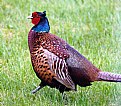| Photography Forum: Medium Format Photography Forum: |
 |
Q. Medium format Newbie needs help

Asked by Q Zhang
(K=3946) on 12/29/2006
|
Hi !! I just picked up a Mamiya 645 1000s with the 80mm/f2.8 stock lens. Sort of a Christmas prezzy for my self. This is my first foray into medium format so I have the inevitable few 'stupid' questions.
1) How does one meter a distant object without a built in meter ? I have a Minolta Autometer IVf, but I can't use that can I ? ex. a sunset, a building, etc.
2) I got the camera and lens really cheap so I have money for 1 or 2 more lenses depending on my luck with eBay. What should I get ? 35mm, 45mm, 150mm, or 210mm. By price the 45mm and 210mm are the cheapest. So using the more $$ the better 'rule' I should get the 35mm and 150mm ?
3) I should probably start looking at a good tripod. I've been shooting handheld or with a Manfroto monopod for the last year or two, but this sucker probably needs to be held down. Any opinions on what to get ? I'm looking at portraiture, still life and landscape work.
4) I want to slow down my shooting with this camera, but should I get another film back while I'm at it ? Is the loading/unloading of film that awkward compared to 35mm ?
5) Good colour & b&w films?
|
|
|
|
|
|
|

Doug Fisher
(K=20) - Comment Date 12/29/2006
|
1) can you get a spot meter attachment for that handheld meter?
2) I like the 45 mm a lot but sometimes wish for the extra width of the 35 mm. I would get a 150 over a 210. I have the 210 and it is a sharp lens but the focal length is not short enough and not long enough ;) 150 is a great portrait lens.
4) Remember, you cannot switch film in mid roll with these cameras (at least not easily). If you want to slow down though, I would recommend getting the chimney viewfinder if you don't have one. It really helps me slow down and compose better. If I could only have one finder though, I would go for one of the prisms. Verticals are tough with the chimney.
My $.02
Doug
|
|
|
|

Q Zhang
(K=3946) - Comment Date 12/29/2006
|
1) I probably could. How does it work? I've only used it in a studio.
2) Ok I'll shoot for either a 35mm or 150mm and see how long my money lasts.
4) The body I got comes with a straight prism. I'm going to stick to that for now. I used a WLF once when I was a kid on an old russian gizmo someone had, but I do shoot a lot in portrait.
Cheers, Merry Christmas !!
|
|
|
|

Chris Lauritzen
(K=14949) - Comment Date 1/6/2007
|
If the distant scene is in the same light as where your shooting from just meter where your at. If the scene is in different light then your more likely to need a spot meter or you can guess and bracket the shots.
|
|
|
|

T Crowe
(K=30) - Comment Date 1/7/2007
|
Incident light is what you're looking for. 18% gray card might help. If you don't know how to meter distant objects I would suggest you not worry about more lenses. Buy a hand held meter with an invercone and buy the gray card and learn about incident light.
|
|
|
|

Oliver Racz
(K=169) - Comment Date 9/8/2007
|
Why would he need a gray card with an incident meter? That's the point in an incident meter, you don't need a gray card. You don't need to meter the distant subject. If the light falling on it is the same as on a nearby subject, just take a meter reading of the nearby subject and the exposure should be the same. For color slides I would take a reading in the shadow and one in the highlight, and average it out or expose somewhere in between, according to what brightness level dominates the scene. For black and white, it's a little different. I take an incident reading in the shadow, and that's the exposure I use, then adjust the development for the highlights.
As for lenses, I'd go for more general purpose lenses first, say 45 mm and 150 mm. Unless you're after unusual effects, this should cover most of your work.
|
|
|
|

Q Zhang
(K=3946) - Comment Date 9/11/2007
|
Thanks for the reply Oliver! I've really found a love these cameras. Love the pace and simplicity of it. I now also have a RB67 + 127mm lens. And put the whole thing on a sturdy Manfrotto 190 tripod. Shooting mostly with the middle focal length lenses. I haven't found much that I can not do with those. Just shot my first rolls of Fuji Reale 100 at the grand canyon and in around the south western USA. I cheated and used my D70 in matrix metering mode to meter the scene, then back calculated to 100ISO (The D70 only has 200ISO) to get my exposure. I was running around a lot and my girlfriend was getting impatient. :-) Still have to wait for the images though.
Take care.
|
|
|
|
|
















